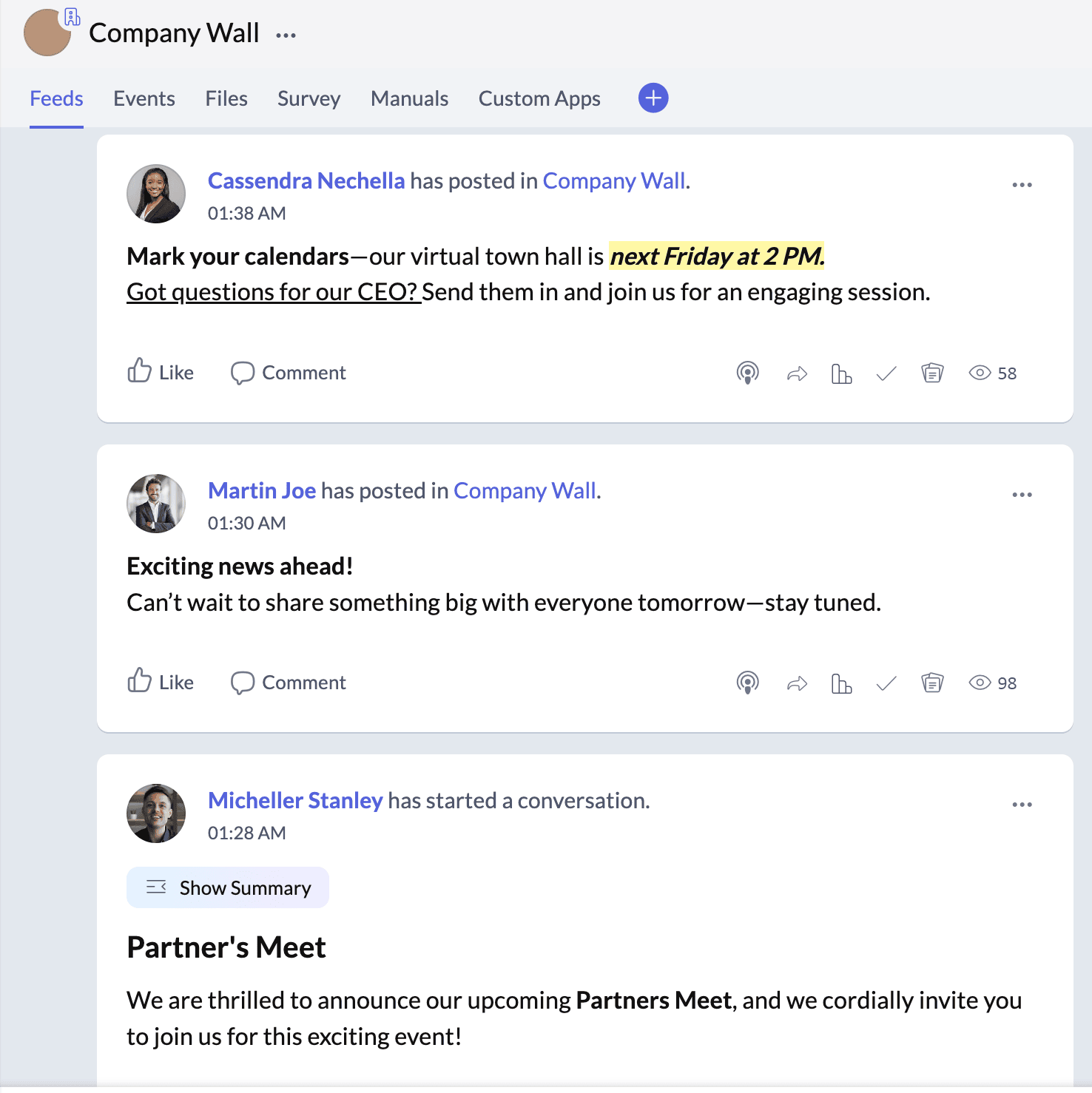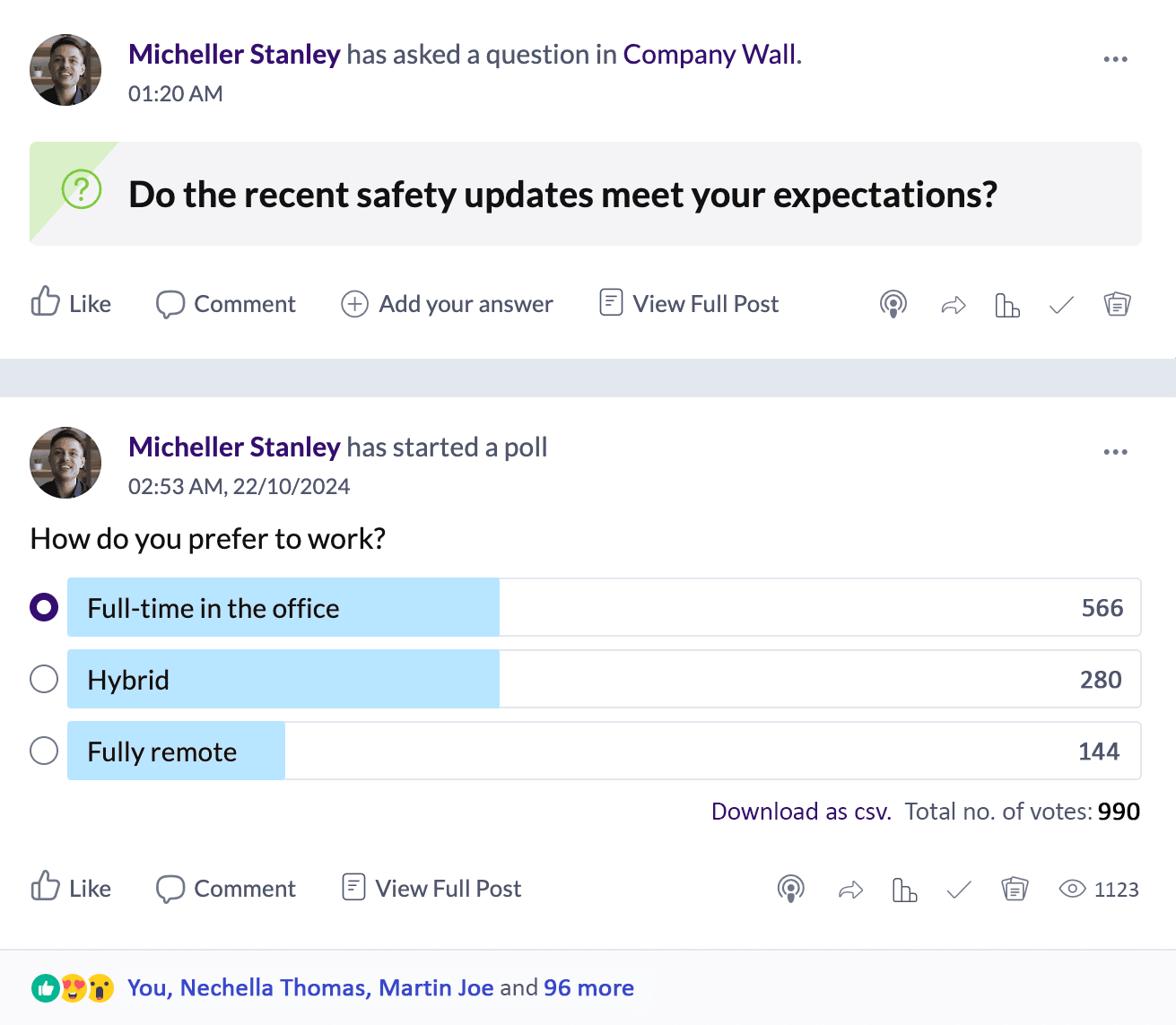Best practices for internal communication
Ensure clear, consistent, and open communication across all channels to keep your employees aligned, informed, and engaged.
Free for 15 days
No credit card required


The challenges in internal communication
Effective communication is crucial for any successful organization, but many businesses encounter common hurdles that can disrupt smooth interactions. Whether it's managing too much information or struggling with employee engagement, these issues can affect productivity and team spirit. Let's look at some everyday challenges in internal communication and how they impact your workplace.

Common issues and barriers
Information overload and black holes
One significant challenge is information overload. Employees often receive too many messages and updates, making it hard to process and prioritize critical information. This can create communication black holes, where important details get lost or go unnoticed, leading to confusion and missed deadlines. The more cluttered communication gets, the harder it becomes to stay organized and on top of things.
Lack of engagement and feedback
When companies face engagement challenges, it’s often because of feedback issues and employees not feeling valued. Without proper feedback, employees can become disengaged, lose motivation, and miss chances to improve. This not only affects their enthusiasm but also their productivity. In fact, low-engagement teams typically endure turnover rates that are 18% to 43% higher than more engaged teams.
Unclear company policies and culture
If employees don’t fully understand company rules or the overall culture, it can cause confusion. Misunderstandings and mistakes are more likely to happen when there’s no clear direction on how to behave or what’s expected, making it difficult to create a unified, effective workplace.
Fragmented communication channels
Using too many different communication tools—like emails, chat apps, and project management platforms—can scatter information. Important messages can get lost across different platforms, making it harder for employees to keep track of conversations. This lack of cohesion can lead to missed messages, impacting effective communication.
Ineffective communication tools
Outdated or hard-to-use communication tools can create more problems than they solve. If employees struggle with tools that don’t work well or aren’t secure, it can slow them down and even lead to mistakes. Using the wrong tools for communication can also increase frustration, further reducing productivity.
Lack of transparency
When communication between managers and employees isn’t clear or open, it leads to confusion and uncertainty. Without transparency, employees may not know what’s happening in the company, causing them to feel disconnected and unmotivated. This lack of openness can also result in mistakes, missed deadlines, and low morale.
Language barriers
For global teams, language barriers can pose a real challenge. When employees don’t share the same language, it’s easy for important information to be misunderstood or miscommunicated. This can slow down projects and create unnecessary confusion.
Remote work challenges
Working remotely can make employees feel isolated and disconnected from their coworkers. Without face-to-face interactions, it’s harder to maintain strong connections and spontaneous communication, which are crucial for teamwork. This can affect how well teams collaborate and interact.
Cultural differences
On diverse teams, cultural differences can lead to misunderstandings. What’s normal or acceptable in one culture may not be in another, leading to confusion. If not handled properly, these differences can complicate communication and lead to misinterpretations.
Technology gaps
Some employees may not be as comfortable using new technology, leading to delays in communication. If they aren’t properly trained, they may struggle with communication tools, which can slow down productivity and disrupt workflows. Ensuring that all employees are up-to-date with technology is essential to smooth and efficient communication.
Transform your workplace communication.

Solutions and strategies for overcoming challenges
Overcoming internal communication hurdles requires a strategic approach. Here are some actionable steps you can take to address and resolve common communication issues within your organization.
Improve communication channels and tools
This follows a hierarchical structure that can either be top-down or a bottom-up approach. The information passes from members or teams in a linear manner based on their designations. For example, senior management communicates budget-related information to managers, who then pass it on to the leaders on their team, who then pass it on to the members of their team.
Enhance employee engagement and feedback mechanisms
When employees feel unheard, morale can take a hit. To boost engagement, it's essential to create a culture of open dialogue and regular feedback. When you use effective feedback mechanisms like surveys, polls, and AMA sessions and take action on that feedback, employees will feel valued and stay motivated.
Recognize and reward achievements
Acknowledging hard work is essential for morale. By setting up recognition and reward systems, businesses can motivate employees and create a positive work environment. Whether through shout-outs, rewards for milestones, or employee-of-the-month programs, celebrating achievements helps employees feel appreciated.
Keep employees updated
Providing consistent updates through company-wide meetings, newsletters, or internal announcements keeps everyone in the loop. This promotes transparency, builds trust, and ensures that employees remain informed about important news or changes in the company.
Provide translation services
Global teams often face language barriers that hinder effective communication. Offering translation services or multilingual communication tools ensures that everyone understands key messages, fostering inclusivity and promoting smoother communication across different languages.
Schedule frequent interdepartmental meetings
Arrange regular meetings between departments to discuss goals, share updates, and address challenges. This practice helps align teams, improves coordination, and ensures that everyone is informed and working towards common objectives.
Develop comprehensive onboarding programs
Create detailed onboarding programs to introduce new hires to company policies, culture, and expectations from the start. With good onboarding, they'll be well-equipped to use communication tools effectively and integrate smoothly into the team.
Offer cultural competence training
Cultural misunderstandings can arise on diverse teams. By providing cultural competence training, businesses help employees better understand and respect cultural differences, leading to a more harmonious and inclusive work environment.
Plan virtual team-building activities
When you have remote teams, staying connected can be a challenge. Organizing virtual team-building activities and regular check-ins helps create a sense of belonging. Activities like online games or virtual coffee breaks strengthen relationships, making remote employees feel more engaged.
Train employees on new technology
Introducing new technology can be difficult for employees. Providing adequate training and support helps them become comfortable with new tools, boosting their confidence and improving productivity. It also ensures that employees can fully utilize the technology to create a better workflow and foster collaboration.
What are the best practices for good internal communication?
Good internal communication is a must for a happy and productive workplace. When everyone’s looped in, things run smoothly, and people feel more connected and motivated. In a busy work environment, getting communication right is more important than ever. Here are some best practices to ensure that your internal communication is clear, engaging, and impactful.
Ensure clear and consistent messaging
To keep everyone informed, it’s crucial to have clear messaging in your internal communications. This means avoiding jargon and keeping your messages straightforward and easy to understand. Consistent communication is equally important. Make sure that the information you share is uniform across all channels and updates. This helps prevent confusion and ensures that everyone receives the same message.
Encourage two-way communication
Fostering two-way communication is essential for a vibrant workplace. Create open feedback channels where employees feel comfortable sharing their thoughts and opinions. By actively seeking employee input, you can address concerns, acknowledge suggestions, and make everyone feel heard. This approach not only improves morale but also enhances overall communication within the organization.
Use data and feedback for continuous improvement
To keep improving, leverage feedback mechanisms effectively. Regularly collect and analyze feedback to identify areas for improvement in your communication strategies. Communication enhancement should be an ongoing effort, using insights from the data you collect to refine and adapt your methods. Embrace a mindset of continuous improvement to ensure your internal communication evolves and meets the needs of your employees.
Tailor communication for different audiences
Not all employees consume information the same way. Some may prefer detailed emails, while others respond better to visuals or quick updates. Understanding the preferences of different teams or departments and tailoring your communication to fit their style ensures that your message resonates with everyone. Personalized communication makes employees feel heard and understood.
Choose the right communication channels
In today's digital age, there are multiple ways to communicate, but not all methods are ideal for every message. Use the right channel for the right message—send formal updates through emails, encourage informal conversations in chat tools, and deliver urgent messages via direct notifications. Choosing the appropriate channels ensures that your communication is timely and effective.
Be transparent with updates
Employees appreciate transparency, especially when it comes to important company updates. Whether it’s about organizational changes, new policies, or even challenges the company is facing, being open and honest with your employees builds trust. When you keep your employees in the loop, they feel more involved and connected to the organization’s overall mission and goals.
Create a centralized hub for information
Make it easy for employees to access important documents, policies, and updates by creating a centralized hub, like an intranet or internal portal. This reduces confusion and ensures that everyone has access to the same information whenever they need it. Having a go-to place for all essential communication and resources can make work easier and improve productivity.
Provide training on communication tools
Maximizing the benefits of internal tools requires proper training. By offering guidance on internal communication platforms, employees stay connected and make the most of tools like project management apps, video conferencing, or messaging. Clear instructions and regular training can minimize miscommunication and boost teamwork.
Encourage regular face-to-face interactions
While digital tools are essential, don’t underestimate the power of face-to-face communication. Regular team meetings, one-on-ones, and even casual conversations build stronger relationships and help clarify messages that might be misunderstood in writing. Whether in person or through video calls, face-to-face interactions promote better understanding, reduce miscommunication, and build stronger team dynamics.
Celebrate achievements
Recognition goes a long way in motivating employees. Make it a habit to celebrate individual and team successes, whether it's through company-wide shout-outs, dedicated recognition platforms, or simple thank-you notes. Acknowledging your employees' efforts makes them feel appreciated and boosts morale, while also reinforcing positive behavior and contributing to a supportive company culture.
By following these practices, you’ll boost internal communication, making your workplace more connected, productive, and happy.
Build a workplace where every voice matters.
How can internal communication platforms like Zoho Connect help?
Staying connected and informed in a modern workplace can be tough, especially when teams are spread across different locations and time zones. Internal communication platforms like Zoho Connect make it easier to keep everyone aligned and engaged. Whether you need to share important news, gather quick insights, or break down language barriers, Zoho Connect has you covered.
Our company wall gathers all key updates—from CEO announcements to important news—in one place, ensuring that everyone stays informed at all times.

With our instant polls and questions, you can engage employees, gather insights, and make decisions faster while fostering a culture of inclusiveness.

Custom notifications, mentions, and pinned posts make sure the right information reaches the right people, keeping your communication efficient and streamlined.

From direct messages to group channels, we make real-time communication and collaboration easy, so your teams can stay productive and connected, no matter where they are.

Our built-in translation feature makes it easy for global teams to collaborate, ensuring that language barriers don’t stand in the way of meaningful contributions.

Forums, organized topics, and an accessible organizational chart let employees easily find what they need, encouraging open communication and transparency.

Keep your employees connected, informed, and engaged with Zoho Connect—no matter where they are.
Free for 15 days
No credit card required
Looking to understand internal communications better?
Get started here.








